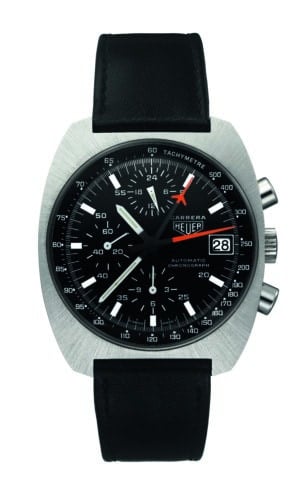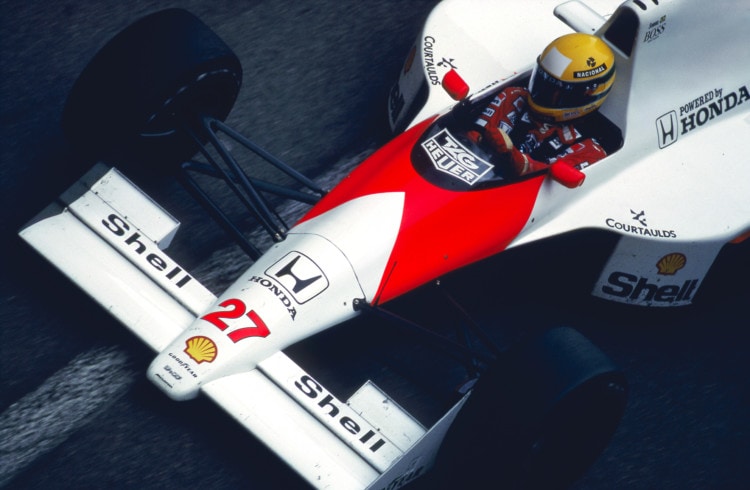The 80s: A Legendary Caliber, the Lemania Carrera Chronograph
The Heuer Carrera in the 1980s
The Eighties were a decisive decade for the future of Heuer: the TAG corporate group assured the future of the prestigious brand. Heuer became TAG Heuer and the Carrera chronograph was reborn with a new movement.
The Quartz Crisis strongly affected the watchmaking industry in late Seventies and early Eighties. Cheap electronic watches from the Far East inundated the world’s markets. Jack Heuer had recognized the trend toward quartz and electronics at an early date and successfully deployed these new technologies in timekeepers for auto races. One of his most successful creations was the Heuer Chronosplit, a quartz wristwatch with a built-in stopwatch function. A quartz version of the Carrera also came onto the market in 1978. The Carrera-Twin series combined conventional hands for the ordinary time of day and LCD indicators for the date and the stopwatch. The quartz-powered Carrera was also available in a purely three-handed version. The traditional brand from Bienne was nonetheless hard pressed to cope with the twin challenges posed by a strong Swiss franc and cheap competition. Jack Heuer was compelled to sell his company in 1982. The man who had invented icons like the Heuer Carrera and the Heuer Monaco, who had co-invented the automatic chronograph and whose innovative marketing in motorsport had transformed Heuer into the global brand we know today lost the company that he had inherited from his forebears. Eighty percent of the shares were taken over by the Piaget Family and another ten percent went to the Swiss movement manufacturer Nouvelle Lémania, which thus became the second-largest shareholder.
For more information got to https://www.tagheuer.com/en/watches/tag-heuer-carrera
 Heuer Carrera 5100 Lemania Chronograph: Piaget and the movement manufacturer Nouvelle Lémania acquired Heuer in 1983. The Carrera was now equipped with the new co-owner’s automatic Caliber Lémania 5100. Two distinguishing features are the orange, readily legible, centrally axial, aircraft-shaped minute-hand and the 24-hour display at “12 o’clock.”
Heuer Carrera 5100 Lemania Chronograph: Piaget and the movement manufacturer Nouvelle Lémania acquired Heuer in 1983. The Carrera was now equipped with the new co-owner’s automatic Caliber Lémania 5100. Two distinguishing features are the orange, readily legible, centrally axial, aircraft-shaped minute-hand and the 24-hour display at “12 o’clock.”
The Carrera Chronograph was revived again between 1983 and 1985, but the brand’s own Caliber 11 and its successors were no longer available. The Carrera was now equipped with the Lemania 5100, a movement made by the label’s new co-owner. The Lemania Carrera was available with a stainless steel case (either with or without a coating of black PVD) and in a gold version. The minute-hand, which was shaped like an airplane, is a distinguishing feature of watches encasing this self-winding movement. Despite several shortcomings (e.g. plastic was used in the Lemania 5100 and the movement per se was by no means an aesthetic masterpiece), this caliber is still regarded today as an outstanding automatic chronograph movement. Not only did it run precisely, it was also lightweight, robust and resistant to centrifugal forces: these virtues made it popular among military men and aviators around the globe. Good legibility likewise ranked among the strong points of the Lemania 5100 Carrera. With all this in mind, it comes as no surprise to learn that the Lemania Carrera is eagerly sought by contemporary collectors.
For more information got to https://www.tagheuer.com/en/watches/tag-heuer-carrera
In 1984, Yves Piaget found in Akram Ojjeh, the president of the Saudi Arabian corporate group TAG (Techniques d’Avant-Garde), a new purchaser who had both the passion and the financial wherewithal to assure a bright future for the Heuer brand. Among the several commonalties that TAG shared with Jack Heuer were a savvy instinct for the zeitgeist and a commitment to motorsport. TAG served as a sponsor of the Williams Formula One racing stable in 1982. Together with Porsche, an engine was developed for McLaren. The group was also active in the luxury industry and in state-of-the-art technology. After TAG purchased 52% of Heuer’s shares from Piaget and Lemania in 1985, Heuer became TAG Heuer. The new management changed the model policy. The new directorship under Christian Viros sharpened TAG Heuer’s profile as a manufacturer of sporty watches. These new timepieces had a more muscular look with broader cases and wider bezels. Wholly new and emphatically sporty models were launched: these included the Formula 1 and the S/el. The abbreviation with the forward slash stands for “Sportiness” and “elegance.” The Heuer 2000, which was designed by Eddy Schöpfer, was likewise continued. And quartz calibers were rediscovered to augment mechanical movements.

Heuer became TAG Heuer in the mid 1980s. TAG and Heuer fit well together, and not solely because both firms were active in motorsport. The new TAG Heuer logo was soon an integral part of Formula One: here, for example, on Ayrton Senna’s McLaren with Honda engine.
A new zeitgeist at the end of the 1980s proved beneficial for TAG Heuer. This was an era when status symbols were gaining favor, also among young people. Films such as “Wall Street” (1987) and “Cocktail” (1988) celebrated the dream of quick money and, above all, what those fast bucks can buy. The dream-come-true career in this epoch? Wall Street banker! The Western market economy also triumphed in global politics. There were plenty of reasons to enjoy all this prosperity and to flaunt what one had – also on one’s wrist.
By the mid 1990s, TAG Heuer’s revenues had increased by a factor of six. The time had come to strengthen the brand’s identity once again. A retrospective gaze into the firm’s history discovered plenty of potential inspirations. The return of the Carrera was imminent.
For more information got to https://www.tagheuer.com/en/watches/tag-heuer-carrera
Discover more about the history of the Carrera on the occasion of its 55th birthday. Click here for an overview of the different decades.

